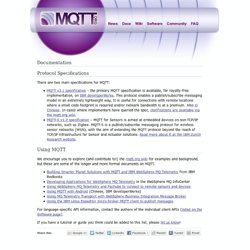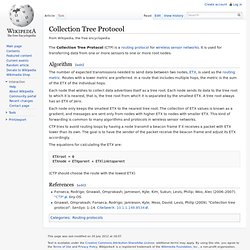

Documentation. Documentation Protocol Specifications There are two main specifications for MQTT: MQTT v3.1 specification – the primary MQTT specification is available, for royalty-free implementation, on IBM developerWorks.

This protocol enables a publish/subscribe messaging model in an extremely lightweight way. It is useful for connections with remote locations where a small code footprint is required and/or network bandwidth is at a premium. Using MQTT We encourage you to explore (and contribute to!) For language-specific API information, contact the authors of the individual client APIs (listed on the Software page).
MQTT V3.1 Protocol Specification. This specification is split into three main sections: the message format that is common to all packet types,the specific details of each packet type,how the packets flow between client and server. Information on how topic wildcards are used is provided in the appendix. 1.1. Changes The following are the changes between MQTT V3 and MQTT V3.1: User name and password can now be sent with a CONNECT packet New return codes on CONNACK packets, for security problems Clarification that clients are not informed of un-authorized PUBLISH or SUBSCRIBE commands, and that the normal MQTT flow should complete even though the command has not been performed.
The protocol version number passed with CONNECT packets, is unchanged for this revision, and remains as the "3". The message header for each MQTT command message contains a fixed header. The message header for each MQTT command message contains a fixed header. Byte 1 Contains the Message Type and Flags (DUP, QoS level, and RETAIN) fields. Byte 2 Flags QoS. An Open Source MQTT v3.1 Broker. The Collection Tree Protocol (CTP)
Note This memo documents a part of TinyOS for the TinyOS Community, and requests discussion and suggestions for improvements.

Distribution of this memo is unlimited. This memo is in full compliance with TEP 1. This memo documents the Collection Tree Protocol (CTP), which provides best-effort anycast datagram communication to one of the collection roots in a network. CTP is a tree-based collection protocol. The CTP protocol assumes that the data link layer provides four things: Provides an efficient local broadcast address.Provides synchronous acknowledgments for unicast packets.Provides a protocol dispatch field to support multiple higher-level protocols.Has single-hop source and destination fields.
CTP assumes that it has link quality estimates of some number of nearby neighbors. CTP has several mechanisms in order to improve delivery reliability, but it does not promise 100% reliable delivery. CTP is designed for relatively low traffic rates. CTP addresses loops through two mechanisms. Collection Tree Protocol. The Collection Tree Protocol (CTP) is a routing protocol for wireless sensor networks.

It is used for transferring data from one or more sensors to one or more root nodes. Algorithm[edit] The number of expected transmissions needed to send data between two nodes, ETX, is used as the routing metric. Routes with a lower metric are preferred. In a route that includes multiple hops, the metric is the sum of the ETX of the individual hops. Each node that wishes to collect data advertises itself as a tree root. Each node only keeps the smallest ETX to the nearest tree root. CTP tries to avoid routing loops by having a node transmit a beacon frame if it receives a packet with ETX lower than its own. The equations for calculating the ETX are: ETXroot = 0 ETXnode = ETXparent + ETXlinktoparent (CTP should choose the route with the lowest ETX)